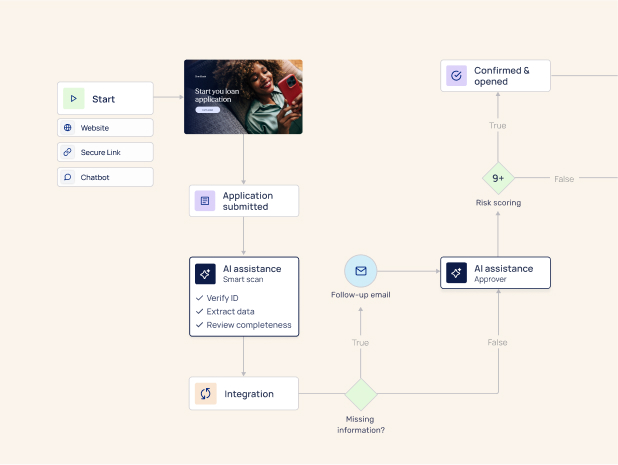The insurance customer data landscape is constantly evolving. New technologies enable insurers to collect customer data in more innovative and efficient ways.
PDF and web forms have long been the traditional methods for customer data capture in the insurance industry. However, these methods are becoming increasingly outdated and inefficient.
Today new customer data capture technologies are beginning to gain traction. Digital data intake journeys, conversational user interfaces (UIs), and chatbots are some ways insurers collect customer data. These methods are not only more efficient than traditional techniques, but they also provide a better customer experience.
Let's take a closer look at each customer data collection method.
Digital data collection journeys
A digital customer journey is a customer's online experience with a brand from start to finish. It includes all the touchpoints a customer has with a brand, such as visiting the website, interacting with customer service, etc.
Insurance companies must collect data and signatures at several customer touchpoints to underwrite a policy. In the past, this process was paper-based and required customers to physically sign documents at each touchpoint.
With digital customer journeys, insurers can collect customer data and signatures via a guided digital process. Digital customer journeys simplify the customer experience by guiding customers through the process step-by-step, making it easier and faster for customers to provide their information. Digital data collection makes the customer experience more seamless and enables insurers to collect data more quickly and efficiently.
Digital data collection journeys have the following benefits:
- Efficient data collection: Data is collected in digital format and is stored electronically, making it easy to access and manage.
- Reduced customer effort: Customers no longer have to physically sign documents at each touchpoint, which makes the customer experience more seamless.
- Improved customer satisfaction: Digital customer journeys provide a more personalized and convenient customer experience.
- Digitally accessible and integrated: Automatically integrate collected data into your workflows and systems. By collecting data digitally, EasySend makes your customer data digitally accessible across channels and is easy to incorporate into your existing workflows, business processes, and internal systems.
The main features of digital data intake journeys include:
- Advanced validation: Customer data is validated in real-time to ensure accuracy and completeness
- Electronic signatures: Customer signatures are collected electronically
- Data integration: Customer data is automatically integrated into your workflows and systems
- Co-browsing: Customer service representatives can view the customer's screen to provide guidance and support
- Personalized flows: Customer journeys are personalized to the customer's needs
- A/B testing: Customer journeys can be tested and optimized for customer conversions
However, digital intake journeys are resource-intensive to build and manage and require significant technical expertise and resources. In addition, customer journeys must be constantly updated to reflect customer needs and process changes.
Conversational UIs and chatbots
[.emph]Conversational UIs are powered by artificial intelligence (AI) and enable two-way communication between customers and insurers.[.emph]
Conversational UIs are becoming increasingly popular as they provide more natural and customer-centric communication. They also allow customers to get the information they need quickly and easily.
In the insurance industry, conversational UIs can be used for customer data collection in several ways. For example, they can be used to collect customer information during the quote process. They can also be used to provide customer service or to answer customer questions about policies.
A conversational UI is a user interface that allows users to interact with a brand using natural language instead of buttons or icons. One example of a conversational UI is a chatbot. A chatbot is a software application that enables users to interact with a brand using natural language.
Chatbots are becoming increasingly popular in the customer service industry. They allow brands to provide a more human-like customer service experience without dedicating expensive human resources to tasks that can be handled by technology, such as collecting customer data, including contact information or policy details to later route the customer further in the company's workflow.
This type of customer data collection allows insurers to collect customer data in a way that is more natural and less intrusive while saving resources. The goal of a conversational UI is to make the customer experience as natural and human-like as possible without dedicating expensive human resources to routine tasks.
However, many challenges must be addressed (such as ensuring data quality and privacy) before insurers can widely adopt chatbots,
When not executed properly, customer data collected through chatbots can be of poor quality. This is because customer data collected through chatbots is often unstructured and can be difficult to verify.
[.emph]Chatbots can also be frustrating for customers and are not well equipped to handle nonstandard requests.[.emph]
Another challenge is customer privacy. Insurers need to ensure that customer data collected through chatbots is stored securely and is not shared with unauthorized third parties.
Digital customer journeys, conversational UIs, and chatbots are all emerging technologies that have the potential to transform customer data collection in the insurance industry. Each of these technologies has its own advantages and challenges that need to be considered before they can be widely adopted.
- Digital customer journeys are more convenient for customers and provide a more personalized customer experience. However, they require insurers to have a customer-centric approach to data collection and are resource-intensive to build and maintain.
- Conversational UIs and chatbots are powered by artificial intelligence and can provide a more natural customer experience. However, there are challenges that need to be addressed before they can be widely adopted, such as ensuring data quality and customer privacy.
No-code customer journeys
Digital journeys are the best option for customer data collection when executed properly. However, as we mentioned above, they can be resource-intensive to build and maintain.
Low-code and no-code platforms are democratizing the digital experience. A low-code/no-code platform is a software platform that enables the rapid development of applications with minimal coding.
No-code customer journeys are created using a drag-and-drop interface that allows businesses to build and deploy state-of-the-art digital experiences quickly.
No-code customer journeys are becoming increasingly popular. They allow businesses to create user-friendly customer journeys with advanced functionality without the need for expensive and time-consuming IT projects. To learn more about this approach, download our ebook on the topic.





